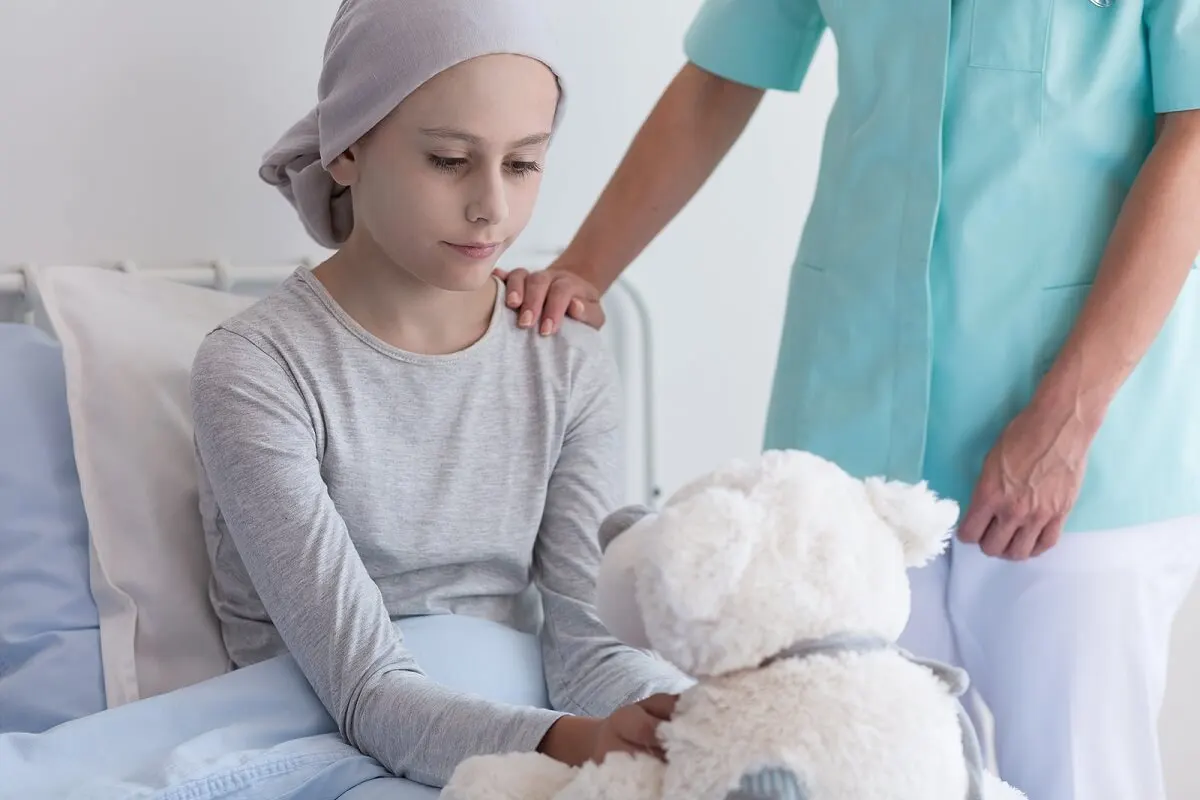What is Neuroblastoma and How Is It Treated?


Written and verified by the doctor Leonardo Biolatto
Neuroblastoma is a rare type of tumor that originates from nerve tissue. It’s a type of cancer that usually affects children under 5 years of age, although it can occur at any age.
It’s usually located in the adrenal glands, which are the glands above the kidneys. However, other places are also sites of settlement, such as the neck, abdomen, and thorax, although to a lesser extent.
The truth is that, in some cases, no treatment is necessary. However, in others, this tumor puts the life of the sufferer at risk. Therefore, in this article, we’ll explain everything you need to know about neuroblastoma.
What is neuroblastoma?
Neuroblastoma is a malignant tumor that originates in the nervous system. Its name comes from the Greek neuron, which means ‘nerve’, and from blastos, which refers to ‘cell’. The suffix -oma means ‘tumor’.
According to an article published by the Association of Relatives and Friends of Neuroblastoma Patients, it develops in the sympathetic nervous system. This is the part of the nervous system that allows us to react to dangerous situations, activating the organism.
This tumor usually affects children. In fact, it’s the most common during the first 2 years of life. It’s estimated that 1 in 7,000 live newborns has it. Moreover, it represents almost 10% of all pediatric tumors.
The reason is that it’s an embryonal tumor. It can appear in any part of the autonomic nervous system. However, the most common area is the adrenal glands. It can also metastasize and spread to other parts of the body.

Symptoms of neuroblastoma
The symptoms of neuroblastoma vary depending on the location of the tumor. As mentioned above, the adrenal glands are the site of predilection.
In this case, abdominal pain is common. In addition, in most patients, a mass can be palpated under the skin. It is frequent that the intestinal rhythm is altered, and both diarrhea and constipation may appear.
According to Mayo Clinic specialists, neuroblastoma also appears in the thorax. When this occurs, there is usually wheezing (noises when breathing) and chest pain. Another characteristic sign is anisocoria, in which the pupils are unequal in size.
As with other cancers, unexplained weight loss, malaise, and fever are part of the syndrome. Some patients have especially protruding eyes (called proptosis).
The main causes and risk factors
As with any other type of cancer, the underlying cause of neuroblastoma is that the cells begin to proliferate out of control. The reason for this is genetic mutations.
This is why they multiply uncontrollably and form a mass that interferes with healthy tissue cells. In this case, it occurs in the sympathetic nervous system. The cells are called neuroblasts.
Neuroblasts are embryonic cells that mature into nerve cells as such. According to a Cleveland Clinic publication, these cells are usually mature at birth.
What happens is that some children are born with a small percentage of immature neuroblasts. If they mutate and proliferate they give rise to the disease.
In reality, the exact cause is not precisely known. However, children with a family history of neuroblastoma are more likely to have it.
Possible complications
Neuroblastoma can, in some cases, lead to serious complications. If the primary tumor spreads to other parts of the body there are metastases that alter the functionality of the tissues.
On the other hand, if the neuroblastoma is located close to the spinal cord it can compress it. Depending on which nerves are affected, multiple neurological sequelae will appear. For example, this may include paralysis, sphincter disturbances, and neuropathic pain.
Neuroblastoma cells can secrete a number of chemicals or hormones. These exert their action in numerous parts of the body. They can give rise to the so-called paraneoplastic syndrome.
For example, they may secrete catecholamines. These are substances responsible for stimulating the body, leading to vasoconstriction, tachycardia, and nervousness. The consequences are alterations in coordination, diarrhea, and abnormal eye movements.
We think you may also enjoy reading this article: A New Study Identifies Mouth Bacteria that May Cause Colon Cancer
How is neuroblastoma diagnosed?
The diagnosis of neuroblastoma is complex. The first step is an extensive physical examination. Since this tumor appears in very young children, the doctor is likely to detect an abnormal mass during a pediatric check-up.
As a KidsHealth article explains, the diagnosis requires a series of complementary tests. One of the most commonly used is a blood and urine test.
In both tests, an increase in certain substances can be observed, which may point to the suspicion of neuroblastoma. As we’ve explained in the previous section, this tumor secretes catecholamines. Therefore, its metabolites increase, and the concentration of homovanillic acid (HVA) and vanillyl mandelic acid (VMA) is measured.
On the other hand, imaging tests are used to localize the tumor. The most commonly prescribed are radiography, ultrasound, and computed tomography. Scintigraphy and an MRI are also used.
As in other tumors, a biopsy plays an essential role. This is a test that consists of extracting a sample of tissue from the tumor and analyzing it in the laboratory. This allows the cells that form the tumor to be studied and the treatment to be determined.
Treatments available for neuroblastoma
The treatment of neuroblastoma depends on the characteristics of the tumor and the risk it presents. In some cases, it’s possible for the tumor to disappear on its own without the need for treatment.
Therefore, it’s sometimes preferable to wait and keep the patient under observation. This is only possible if the tumor is staged as low risk. However, in many other cases, intervention is necessary.
One of the first options is surgery. The aim is to remove the entire tumor. The problem is that, since the nervous system is involved, removal is complex and risky.
For this reason, other techniques are also used, such as chemotherapy and radiotherapy. The former is used if the neuroblastoma is of intermediate or high risk or if there are metastases elsewhere in the body.
Radiotherapy, on the other hand, has no systemic effects. That is, its action is limited to a specific area of the body. It consists of directing the radiation directly to the tumor.

Other treatment options
In cases where surgery, radiotherapy, and chemotherapy fail, other approaches can be attempted. One of the most commonly used is stem cell transplantation, as bone marrow transplantation. Stem cells are cells that can differentiate into any type. In this way, they stimulate the growth of healthy elements.
Another option is retinoids. They are drugs that act in a similar way to vitamin A. They help to prevent the recurrence of neuroblastoma.
Finally, another therapeutic step is immunotherapy. This consists of the use of drugs that stimulate the immune system to fight the tumor. Monoclonal antibodies, which are molecules that specifically bind to tumor cells, are prescribed.
Like this article? You may also like to read: Ewing’s Sarcoma: Symptoms and Treatments of This Rare Form of Cancer
Neuroblastoma is a type of tumor that usually develops in childhood
Neuroblastoma is a tumor that develops from cells of the sympathetic nervous system. This cancer tends to occur in children under 5 years of age.
The most frequent location is the adrenal glands. Although in some cases it can resolve without treatment, in many others it can be life-threatening.
That is why it’s important that children attend all the recommended check-ups with their pediatrician. Above all, it’s essential to consult a doctor if any symptoms or warning signs appear.
All cited sources were thoroughly reviewed by our team to ensure their quality, reliability, currency, and validity. The bibliography of this article was considered reliable and of academic or scientific accuracy.
- Neuroblastoma: What is It, Stages, Causes, Symptoms, Treatments. (n.d.). Retrieved April 21, 2021, from https://my.clevelandclinic.org/health/diseases/14390-neuroblastoma
- Neuroblastoma – Síntomas y causas – Mayo Clinic. (n.d.). Retrieved April 21, 2021, from https://www.mayoclinic.org/es-es/diseases-conditions/neuroblastoma/symptoms-causes/syc-20351017
- Neuroblastoma (para Padres) – Nemours KidsHealth. (n.d.). Retrieved April 21, 2021, from https://kidshealth.org/es/parents/neuroblastoma-esp.html
- Neuroblastoma, síntomas, diagnóstico, etapas, tratamientos, bibliografía |. (n.d.). Retrieved April 21, 2021, from http://asociacion-nen.org/asociacion-nen-neuroblastoma-la-enfermedad-9/conoce-el-neuroblastoma/
This text is provided for informational purposes only and does not replace consultation with a professional. If in doubt, consult your specialist.








